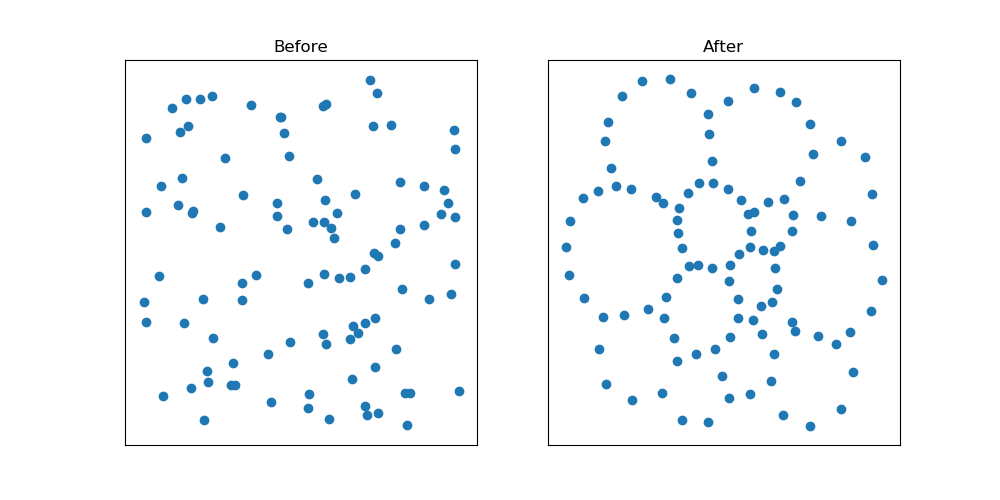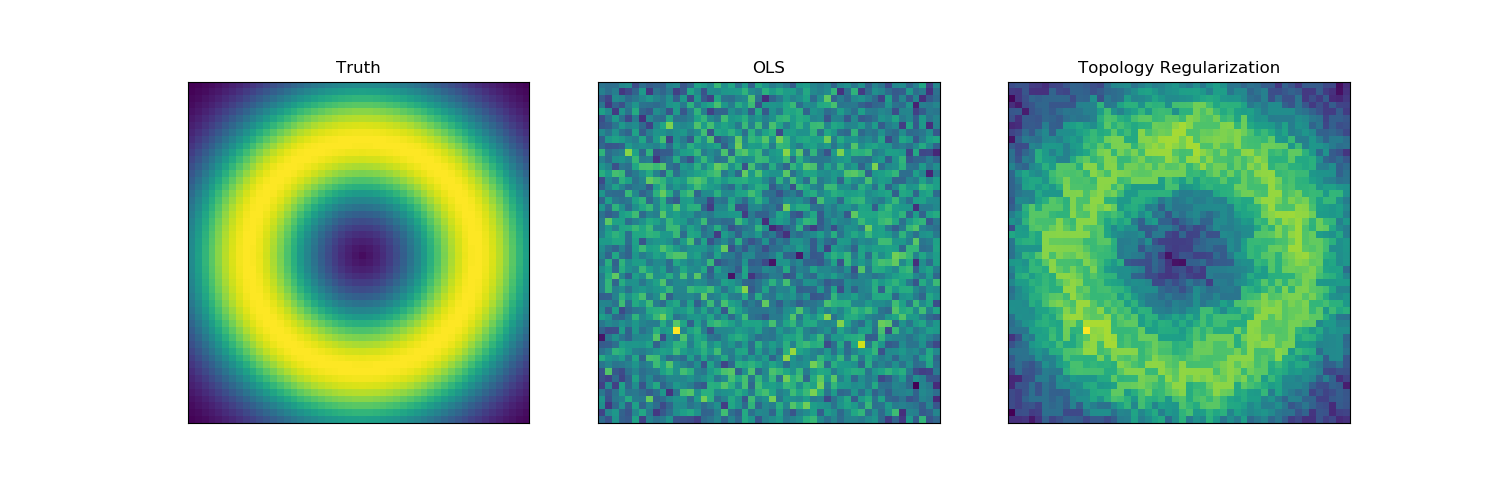Rickard Brüel Gabrielsson, Bradley J. Nelson, Anjan Dwaraknath, Primoz Skraba, Leonidas J. Guibas, and Gunnar Carlsson [arXiv]
AISTATS 2020
@misc{brüelgabrielsson2020topology,
title={A Topology Layer for Machine Learning},
author={Rickard Brüel-Gabrielsson and Bradley J. Nelson and Anjan Dwaraknath and Primoz Skraba and Leonidas J. Guibas and Gunnar Carlsson},
year={2020},
eprint={1905.12200},
}
This repository contains a Python package that implements PyTorch-compatible persistent homology layers, as well as featurization of the output.
For an introduction to this topic, see the paper A Topology Layer for Machine Learning, arxiv:1905.12200
In this example, we increase the size of holes in a random point cloud. full source
from topologylayer.nn import AlphaLayer, BarcodePolyFeature
import torch, numpy as np, matplotlib.pyplot as plt
# random pointcloud
np.random.seed(0)
data = np.random.rand(100, 2)
# optimization to increase size of holes
layer = AlphaLayer(maxdim=1)
x = torch.autograd.Variable(torch.tensor(data).type(torch.float), requires_grad=True)
f1 = BarcodePolyFeature(1,2,0)
optimizer = torch.optim.Adam([x], lr=1e-2)
for i in range(100):
optimizer.zero_grad()
loss = -f1(layer(x))
loss.backward()
optimizer.step()In this example, we use level set topology to regularize a least squares problem y = X * beta + noise. full source
import torch, torch.nn as nn, numpy as np, matplotlib.pyplot as plt
from topologylayer.nn import LevelSetLayer2D, SumBarcodeLengths, PartialSumBarcodeLengths
# see full source for setup of problem
# X, y, and beta_ols are created
class TopLoss(nn.Module):
def __init__(self, size):
super(TopLoss, self).__init__()
self.pdfn = LevelSetLayer2D(size=size, sublevel=False)
self.topfn = PartialSumBarcodeLengths(dim=1, skip=1) # penalize more than 1 hole
self.topfn2 = SumBarcodeLengths(dim=0) # penalize more than 1 max
def forward(self, beta):
dgminfo = self.pdfn(beta)
return self.topfn(dgminfo) + self.topfn2(dgminfo)
tloss = TopLoss((50,50)) # topology penalty
dloss = nn.MSELoss() # data loss
beta_t = torch.autograd.Variable(torch.tensor(beta_ols).type(torch.float), requires_grad=True)
X_t = torch.tensor(X, dtype=torch.float, requires_grad=False)
y_t = torch.tensor(y, dtype=torch.float, requires_grad=False)
optimizer = torch.optim.Adam([beta_t], lr=1e-2)
for i in range(500):
optimizer.zero_grad()
loss = 0.1*tloss(beta_t) + dloss(y_t, torch.matmul(X_t, beta_t.view(-1)))
loss.backward()
optimizer.step()Dependencies:
- Python (2 or 3)
- NumPy
- SciPy
- PyTorch 1.0+
Assuming you have the listed dependencies and pip, you should be able to install.
pip install git+https://github.com/bruel-gabrielsson/TopologyLayer.gitIf you're having issues, see troubleshooting notes below. MacOS users will likely need to see this section to set some necessary environment variables.
First, create a conda environment
conda create -n toplayer # python=2 or python=3
source activate toplayerNow, add dependencies
conda install numpy scipy matplotlib
conda install pytorch torchvision -c pytorchNow, you can install the TopologyLayer package.
pip install git+https://github.com/bruel-gabrielsson/TopologyLayer.gitThis section is primarily for those who wish to modify or contribute to the package. We recommend you do not install using pip as above, but do configure your environment to have the necessary dependencies.
If you haven't already, clone the repository
git clone git@github.com:bruel-gabrielsson/TopologyLayer.gitYou are now ready to compile extensions. PyTorch tutorial on extensions here
Important: in environment, it seems like using the pytorch conda channel is important
source activate toplayer
conda install pytorch torchvision -c pytorchCompilation uses python's setuptools module.
To complile (from TopologyLayer home directory):
source activate toplayer
python setup.py install --record files.txtYou should now have the package available in your environment. You can run the above command any time you modify the source code, and the package on your path should update.
To delete all installed files (from TopologyLayer home directory):
xargs rm -rf < files.txt # files.txt from setup
rm -rf build dist topologylayer.egg-info
rm files.txtThis may be necessary if you need to refresh intermediate build files.
For easiest use, high-level classes are provided for Pytorch compatibility.
The output of the diagram layers is not just a Pytorch tensor, but a tuple, which consists of
- A tuple (again) containing the persistence barcodes
- A flag indicating if the filtration was sub or super-levelset.
The recommended usage is to just pass the return type directly into a feature layer, which will take care of parsing.
The output of extensions will be a tuple of torch.float tensors (one tensor for each homology dimension), and a flag indicating whether computation was sub-level set persistence.
dgms, issublevel = layer(x)dgms[k] is the k-dimensional barcode, where dgms[k][j][0] is the birth time of bar j and dgms[k][j][1] is the death time of bar j.
All bars are returned (including bars of length 0). It will be assumed that a featurization layer can choose to use or ignore these bars.
If you're unfamiliar with persistence, it is probably easiest to get started by just passing a barcode into a featurization layer.
A LevelSetLayer takes in a function on a fixed space, and outputs a super-level set persistence diagram tensor. There are two specialized variants: LevelSetLayer1D and LevelSetLayer2D which operate on 1D and 2D grids.
LevelSetLayer1D only computes 0-dimensional persistence, since this is the only relevant barcode.
import torch
from topologylayer.nn import LevelSetLayer1D, SumBarcodeLengths
# creates a superlevel set layer on a 10-point line.
layer = LevelSetLayer1D(size=10, sublevel=False)
feat = SumBarcodeLengths(dim=0)
y = torch.rand(10, dtype=torch.float).requires_grad_(True)
p = feat(layer(y))LevelSetLayer2D can compute either 0-dim or both 0-dim and 1-dim barcodes. The defualt behavior is to use the freudenthal triangulation of a grid on the specified size, which can be modified using the complex input argument.
from topologylayer.nn import LevelSetLayer2D, SumBarcodeLengths
import torch
layer = LevelSetLayer2D(size=(3,3), maxdim=1, sublevel=False)
x = torch.tensor([[2, 1, 1],[1, 0.5, 1],[1, 1, 1]], dtype=torch.float)
dgms, issublevelset = layer(x)The above should give two non-trivial bars (there will also be trivial bars listed)
dgms[0] = tensor([[2., -inf]]) and dgms[1] = tensor([[1.0000, 0.5000]])
corresponding to the persistence diagrams.
A generic LevelSetLayer can be used with arbitrary SimplicialComplex objects, which is useful to extend beyond 1 and 2-dimensional images. Note that the complex must currently be acyclic for the computation to be correct. The following example is on a star graph:
from topologylayer import SimplicialComplex
from topologylayer.nn import LevelSetLayer
import torch
cpx = SimplicialComplex()
cpx.append([0])
for i in range(1,5):
cpx.append([i])
cpx.append([0,i])
layer = LevelSetLayer(cpx, maxdim=0, sublevel=True)
y = torch.tensor([1,0,0,0,0], dtype=torch.float).requires_grad_(True)
dgms, issublevel = layer(y)Note that the function y has one value for each vertex in the space.
dgms[0] should contain 3 bars of type [0., 1.], one bar of type [0., inf] and one bar of type [1., 1.].
A RipsLayer takes in a point cloud (an n x d tensor), and outputs the persistence diagram of the Rips complex. The Rips layer assumes a fixed complex size n.
import torch
from topologylayer.nn import RipsLayer
n, d = 10, 2
layer = RipsLayer(n, maxdim=1)
x = torch.rand(n, d, dtype=torch.float).requires_grad_(True)
dgms, issublevelset = layer(x)An AlphaLayer takes in a point cloud (an n x d tensor), and outputs the persistence diagram of the weak Alpha complex.
import torch
from topologylayer.nn import AlphaLayer
n, d = 10, 2
layer = AlphaLayer(maxdim=1)
x = torch.rand(n, d, dtype=torch.float).requires_grad_(True)
dgms, issublevelset = layer(x)The AlphaLayer is similar to the Rips layer, but potentially much faster for low-dimensional computations.
Note that a weak Alpha complex is not an Alpha complex. It is better thought of as the restriction of the Rips complex to the Delaunay Triangulation of the space.
These Layers can be used in 1 dimension. However, make sure the input has shape n x 1 and that maxdim=0. Note that in this case, there is really no reason to use RipsLayer over AlphaLayer, since the diagrams should be identical.
RipsLayer example
import torch
from topologylayer.nn import RipsLayer
n, d = 10, 1
layer = RipsLayer(n, maxdim=0)
x = torch.rand(n, d, dtype=torch.float).requires_grad_(True)
dgms, issublevelset = layer(x)AlphaLayer example
import torch
from topologylayer.nn import AlphaLayer
n, d = 10, 1
layer = AlphaLayer(maxdim=0)
x = torch.rand(n, d, dtype=torch.float).requires_grad_(True)
dgms, issublevelset = layer(x)There are several available algorithms for computing persistence, which can be chosen by setting the alg keyword in any layer.
'hom'(default) will run the standard reduction algorithm'hom2'will run the homology reduction algorithm, but will attempt to minimize nonzeros in a heuristic way'cohom'will run the cohomology algorithm
layer = LevelSetLayer1D(size=10, sublevel=False, alg='cohom')Different algorithms may give better performance depending on the application, although 'hom' currently performs fastest on some simple benchmarks.
Persistence diagrams are hard to work with directly in machine learning. We implement some easy to work with featurizations.
A SumBarcodeLengths layer takes the output of a diagram layer, and sums up the lengths of the persistence pairs in a given dimension, ignoring infinite bars.
import torch
from topologylayer.nn import LevelSetLayer2D, SumBarcodeLengths
layer = LevelSetLayer2D((28,28), maxdim=1)
sumlayer = SumBarcodeLengths(dim=1)
x = torch.rand(28,28, dtype=torch.float).requires_grad_(True)
dgminfo = layer(x)
dlen = sumlayer(dgminfo)A TopKBarcodeLengths layer takes in the output of a diagram layer, and returns the top k barcode lengths in a given homology dimension as a tensor, padding by 0 if necessary. Parameters are dim and k
import torch
from topologylayer.nn import TopKBarcodeLengths, LevelSetLayer2D
layer = LevelSetLayer2D(size=(10,10), sublevel=False)
feat = TopKBarcodeLengths(dim=1, k=2)
y = torch.rand(10,10, dtype=torch.float).requires_grad_(True)
p = feat(layer(y))the output should be a tensor of length 2.
A BarcodePolyFeature layer takes in the output of a diagram layer, and returns a polynomial feature as in Adcock, Carlsson, and Carlsson. Parameters are homology dimension dim, and exponents p and q. By defalut, all zero-length bars will be ignored.
import torch
from topologylayer.nn import BarcodePolyFeature, LevelSetLayer2D
layer = LevelSetLayer2D(size=(10,10), sublevel=False)
feat = BarcodePolyFeature(dim=0, p=1, q=1)
y = torch.rand(10,10, dtype=torch.float).requires_grad_(True)
p = feat(layer(y))A PartialSumBarcodeLengths layer takes in the output of a diagram layer, and returns the sum of the barcode lengths in dimension dim skipping the first skip finite bars.
import torch
from topologylayer.nn import PartialSumBarcodeLengths, LevelSetLayer2D
layer = LevelSetLayer2D(size=(10,10), sublevel=False)
feat = PartialSumBarcodeLengths(dim=1, skip=2)
y = torch.rand(10,10, dtype=torch.float).requires_grad_(True)
p = feat(layer(y))If you wish to create new high-level layers for your own purposes, it is useful to know the basics of constructing a simplicial complex. The type made available is named SimplicialComplex
Complex construction can be done in python by initializing an empty SimplicialComplex and using the append method to add simplices as lists of integers.
from topologylayer import SimplicialComplex
X = SimplicialComplex()
# 0-simplices
X.append([0])
X.append([1])
X.append([2])
# 1-simplices
X.append([0,1])
X.append([1,2])
X.append([0,2])
# 2-simplices
X.append([0,1,2])Warning: there are currently no checks to make sure a SimplicialComplex does not contain duplicate simplices, or that all faces are included. Thus, one should be very careful to add all faces and do so exactly once.
Warning: 0-simplices (vertices) are assumed to start with [0] and end at [n] where n is the total number of vertices. You may run into issues if you use a different set of labels.
Warning: the persistence computation currently assumes that the complex is acyclic at the end of the filtration in order to precompute the number of barcode pairs.
You can use topologylayer with tensors that are on GPUs. However, because the persistent homology calculation takes place on CPU, there will be some overhead from memory movement.
There are deprecated functions that call Dionysus (https://mrzv.org/software/dionysus2/) for the persistence calculations. There functions are superseded by the PyTorch Extensions, but may still be used. Note that initialization may differ slightly from the default layers.
source activate toplayer
pip install --verbose dionysusThe corresponding imports are
from topologylayer.nn.levelset_dionysus import LevelSetLayer1D
from topologylayer.nn.levelset_dionysus import LevelSetLayer as LevelSetLayer2D
from topologylayer.nn.alpha_dionysus import AlphaLayer
from topologylayer.nn.rips_dionysus import RipsLayerThe return types should be the same as the extensions, but output may not be identical (zero-length bars are truncated).
This package has been successfully installed/tested on the following systems:
- Fedora 29
- Ubuntu, running on Windows Linux Subsystem
- MacOS High Sierra
Installation has been successful using Anaconda Python. See installation notes above
General Information:
Pass a --verbose flag to pip if you are having any issues.
pip install --verbose git+https://github.com/bruel-gabrielsson/TopologyLayer.gitIf your issue appears to be due to the package, please create an an issue with the following information:
- Your operating system
- Python version, environment setup
- The verbose output of the installation command
- Any other relevant information
MacOS Information:
If PyTorch was compiled using clang++, you may run into issues if pip defaults to g++. You can make pip use clang++ by setting the CXX environment variable. The CPPFLAGS environment variable also needs to be set to look at libc++ to avoid compatibility issues with the PyTorch headers. The MACOSX_DEPLOYMENT_TARGET environment variable may also need to be set (set the target to be whatever your OS version is).
export CXX=/usr/bin/clang++
export CPPFLAGS="-stdlib=libc++"
export MACOSX_DEPLOYMENT_TARGET=$(sw_vers -productVersion)
pip install --verbose git+https://github.com/bruel-gabrielsson/TopologyLayer.git
